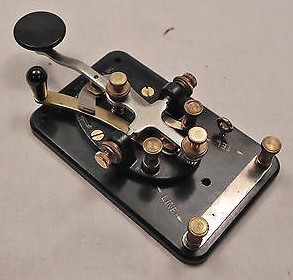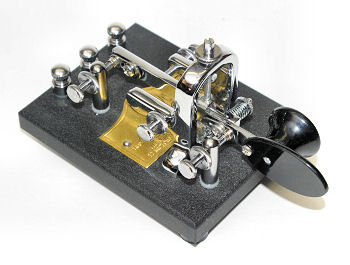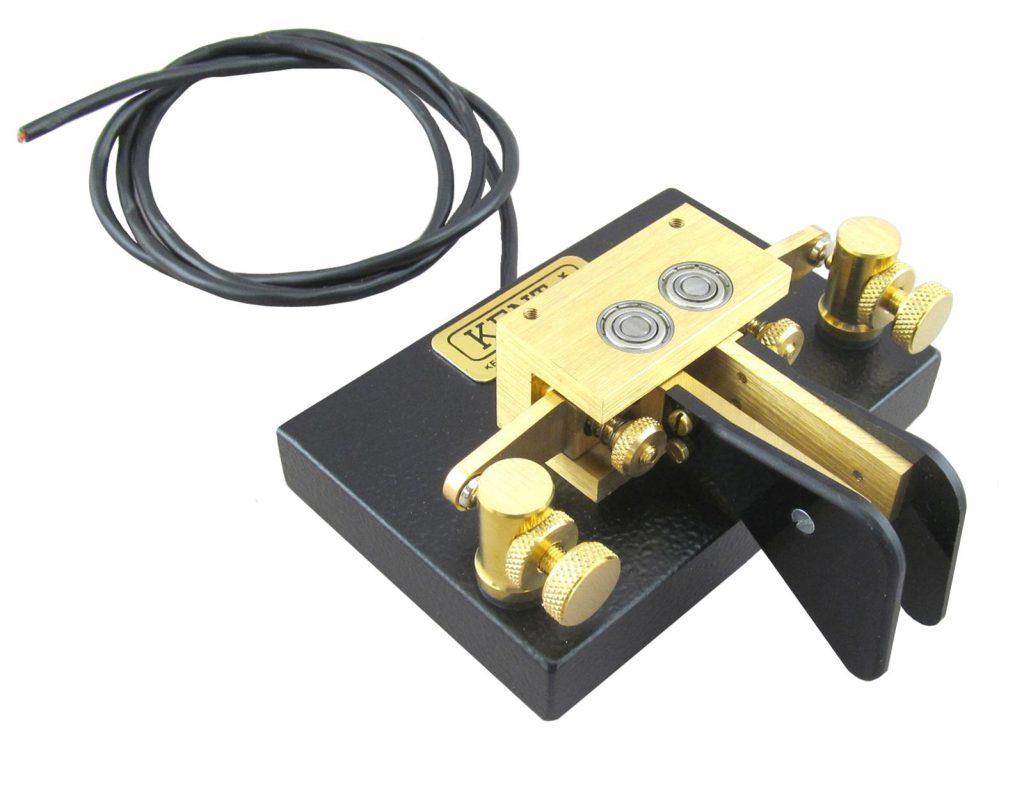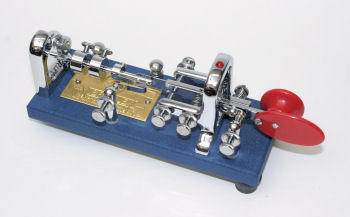Learning Morse code for CW operation has many similarities to learning how to play a musical instrument. Modulating the musician’s maxim about achieving success, “How do you get to the 30 words per minute level? Practice!” It’s true for CW, as well, and so is the importance of choosing a good first instrument, key or paddle. Assuming you are familiar with the general idea of keys and paddles, what’s out there for the beginning CW enthusiast?
Key or Paddle?
This is a question I get frequently—should you start with a key or paddle? My answer is often, “It depends…” because I need to know what your end goals for sending Morse may be. Are you looking to see what over-the-air Morse sounds and feels like before going further? In that case, you can start with a simple key, such as the common J-38 that has launched legions of code fans. If your goal is to participate in CW contesting or DXing or to have long “ragchews” (conversations), then I will steer you to a basic paddle and keyer combination because you can go much faster—much sooner—that way.
You may already know that there are smartphone apps for learning and practicing Morse. The app doesn’t have a “real” key or paddle to send with, so you won’t learn more than some of the letters and the basic structure. Change to an actual key or paddle right away to learn the proper way to send!
The Basic Key

The classic telegraph key used by literally millions of CW operators through the years is the J-38 shown in the photo here. This is called a straight key. The operator grips (not taps) the large knob and by pressing down closes the contacts connected to the terminals at the back of the key. The “shorting bar” with the small knob next to the main knob is used to keep the terminals connected together. Once used to route the telegraph line through the station when not sending, the shorting bar is handy today for keying the transmitter continuously during adjustments.
The key’s main lever arm is suspended in a pair of bearings that are adjusted with the horizontal screws at either side. The vertical screw at the back of the main lever is for adjusting the amount of vertical travel. The vertical screw at the front is for adjusting the spring tension that makes the key’s motion “soft” or “hard” to suit personal preferences. You don’t need much more than those simple adjustments!
What’s missing from the photograph is a large base to hold the key down when being used. The rectangular black base in the photo only holds all the key parts together. It’s common to find keys without the black base; those are perfectly useable, too. You’ll need to mount the key on something your arm can rest on to hold it all where you want it. Chasing a key around the desktop while you’re trying to send is no fun, and it makes for poor code! Any thin piece of plastic or wood about half the length of your forearm will do. A clipboard is about the right size, with its clip removed.
There are quite a few variations on the basic J-38—just enter “J-38 telegraph key” or “morse telegraph key” into an internet search engine. One common variation is to replace the flat knob in the photo with knobs shaped like mushrooms or balls for a better grip. Again, like musical instruments, what type of key feels “just right” is a very personal matter.
You don’t have to buy an antique. There are a number of new keys on the market ranging from the very inexpensive MFJ-550 to the well-made and sturdy Vibroplex family of keys.
Expect a straight key to get you to around 15 wpm (words per minute) of solid, even keying that doesn’t feel rushed. At this point, you’ll find that going much faster takes a lot of work (and practice). Yes, operators do go faster with a straight key, but it’s hard to send smoothly and evenly with the correct weighting (the 3:1 ratio of dahs and dits). This is why I suggest in most cases to start with a paddle.
The Paddle

As you rumble through a string of dits and dahs with a straight key, you’ll no doubt wish there was a better way—and there is! it’s called a paddle. Instead of bouncing a lever up and down while grasping a knob, the paddle is manipulated back and forth by the thumb and first finger. One direction makes dahs and the other dits.
Well, the paddle doesn’t make the bits of code, a device known as an electronic keyer does. The paddle has two contacts and a ground or common connection. These contacts are routed to a stereo (tip-ring-sleeve) connector (both 1/4 inch and 1/8 inch phone plugs are common) that plugs into the keyer. The keyer turns any contact closure into a perfectly formed dit or dah and keys the transmitter as if it were a straight key. Most transceivers have a built-in keyer or you can buy stand-alone keyers.
There are two kinds of electronic keyer paddles: single-lever and dual-lever, both shown here. Using a single-lever paddle is intuitive (a Vibroplex Vibrokeyer is shown). Move the paddle left for dah and right for dit. It is a simple way to learn to use paddles, and you can easily send 30 wpm or faster.
Note the keyer paddle’s heavy metal base. That’s enough to keep it from moving around on the operating desk because it takes a lot less effort to manipulate than a straight key. Paddles can be set to activate with a feather-light touch, or action, but like setting up a musical instrument, it is a matter of personal taste.

Soon, however, you’ll find out about the dual-lever or iambic paddle. This type of paddle has one lever to make dahs and one lever for the dits. The connection to the keyer is the same. Why choose an iambic model? The key, if you will, is in the name. You might remember the term iambic from a literature course referring to the rhythm of poetry as a syncopated sequence of syllables; tra-la-tra-la-tra-la. Substitute di-dah-di-dah-di-dah and you have iambic keying. Alternating dits and dahs are common in Morse, and the iambic keyer makes it easy to send with a dual-level paddle like the Kent twin-lever model by simply squeezing both paddles, which closes both contacts at the same time. Iambic keying is about the fastest way to send Morse. When you hear operators ripping along at 40 wpm or more, if they are doing it manually it’s probably with a dual-lever paddle. Again, there is some practice involved, but soon it will feel as natural as anything.
Why Not a Bug?
Sooner or later, most Morse fans will try their fist at using a semi-automatic key also called a “bug” after the Vibroplex “mascot” and the name of its most famous product, the Lightning Bug. The Blue Racer shown here is a colorful example. (You can clearly see the lineage of the single-lever paddle.) Bugs were invented before electronics were a thing in order to give telegraph operators a way of sending fast.

A weight at the back of the lever vibrates to make the dits while the operator forms the dahs manually. The speed of the vibration depends on where the weight is set along the adjustment rod. This can be a touchy adjustment and requires verve and elan on the part of the operator to make it sound good to the receiving station. I recommend that you develop solid paddle-and-keyer skills before attempting the bug. Try your hand with an off-the-air Code Practice Oscillator first!
Listening to Your Fist
Regardless of what key you choose, you’ll need some kind of audio source to make a tone as you send. This is usually called a “Code Practice Oscillator” or CPO. You can make your own, buy one, or use your HF radio configured to output a sidetone but not transmit. This is usually done by putting the radio in CW mode but turning off the VOX circuits that control the transmitter.
Dit-Dit
That’s a quick overview of the type of Morse machines out there for you to try. For best results, stay with one of these tried-and-true styles at first. Avoid the novelty keys and the unusual or miniature models—although they are fun to try. Practice until you are comfortable and then drop by a key vendor’s table at a local hamfest or convention and start test driving the various styles in earnest. Try a friend’s key or paddle and see what you like and don’t like about it. Keep looking and then, one day, you’ll find your favorite!
I am encouraged by the interest in Ham Radio’s oldest mode, dating back to Samuel Morse’s invention in the 1830s, nearly 200 years ago. Morse has fans of all ages and preferences, in every country. Maybe we’ll cross circuits some day and can send each other the age-old “see you later!” fist-bump of telegraphers the world over— dit dit!

